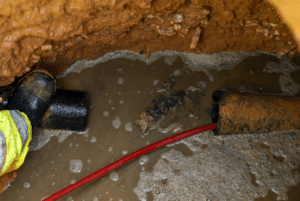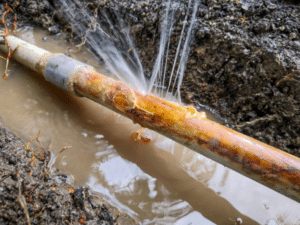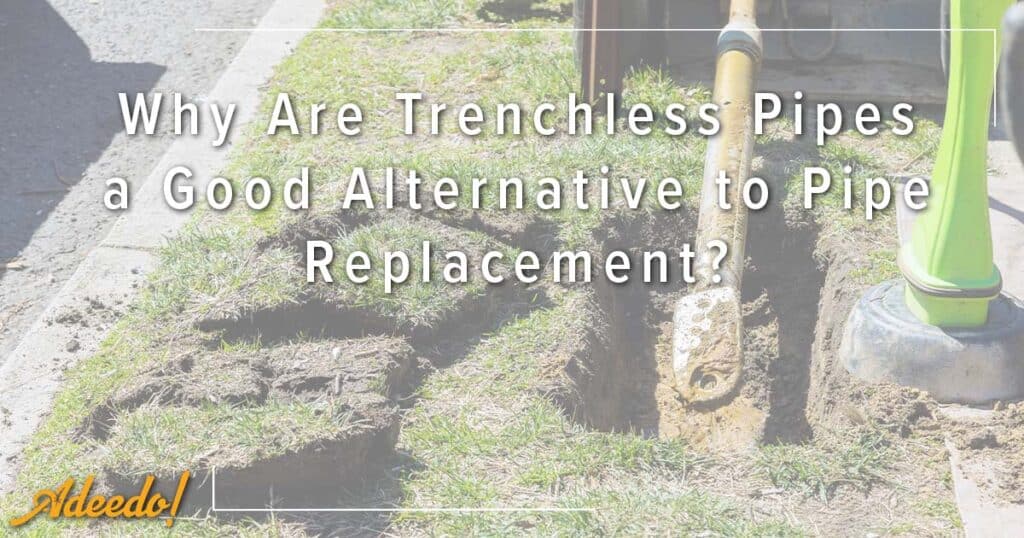When it comes to pipes transporting water to and from your home, older isn’t better. As pipes age, issues may appear and continue, leading to a lot of inconvenience and high repair bills. Suffering through clogged drains and backed-up sinks can be frustrating and overwhelming, not to mention the cost of sewer line repairs.
Plumbers have many ways of performing sewer repair work, but they’re almost always complex and intrusive. Just getting to the pipes can cause damage to sidewalks, yards, and other structures. Fortunately, trenchless pipes can be a good option with lower costs and greater benefits.
Wondering why trenchless pipes a good alternative to pipe replacement? Let’s look at the pros and cons of trenchless pipe repair from the experts at Adeedo.
What Is Trenchless Pipe Replacement?
A traditional sewer pipe replacement is always a dreaded job for homeowners. If you’ve been unlucky enough to have sewer line problems in the past, you know how much this work can stress and inconvenience you.
The truth is, even the finest sewer line with the best materials will eventually succumb to wear and tear. Sewer lines are subjected to incredibly severe operating conditions every day. Over long periods, sewer lines may crack, wear down, leak, or spill sewage on your property.
The only way to fix these problems is with a sewer line repair or replacement. These services are a lot more common than most people would imagine.
In the past, a sewer lateral – which is the pipe that runs from your house to the main sewer line – that had to be repaired or replaced required long trenches along the length of the pipe. This meant not only taking out dirt but also landscaping, plant life, driveways, and anything else that may be in the path.
However, with trenchless technology, plumbers were able to use a “no-dig” method that’s less disruptive to homeowners.
Causes of Sewer Line Damage

Typically, the sewer main, which is the pipe responsible for doing away with waste from a home’s sinks, toilets, tubs, and other drains, is buried and can’t be reached without digging. It’s position underground means it’s more susceptible to damage from roots, shifting earth, and variations in temperature during winter and spring.
For example, if water freezes in the mainline, the expanding ice can trigger severe damage that isn’t revealed until it melts in the spring. This can cause flooded basements or possible health issues that come from exposure to bacteria in the sewage backup.
There are several causes of sewer line cracks and breaks:
- Tuberculation: Tuberculation arises in cast iron pipes over time and is built up of slime with iron-eating bacteria. The bacteria began as ions in the water and began dissolving the pipe. As the pipes begin to break up, the pipe’s interior wall becomes jagged and debris running through the line snags on the wall, producing a clog. The tubercules can swell up, narrowing the pipe’s interior and restricting water flow.
- Tree root infiltration: Sewer lines produced from a porous material, such as clay, are prone to root infiltration. As the trees mature, their roots move deeper and wider in pursuit of water to help grow. Sometimes, they find older, porous lines that make it easier for the roots to latch on and penetrate to get to the water inside. They force into the pipes, causing cracks and line breaks.
- Sagging lines: Sagging lines are something that also happens over time. This is caused by soil conditions shifting to the point where the line starts to lose its support. When this takes place, a belly develops at the low spot along the line. The underside of the line becomes a collection point for waste to accumulate and clog the line. Not like other blockages and clogs, sagging lines are something that a homeowner can’t do much to help – and won’t know if there’s a problem until it’s too late.
- Internal corrosion: Corrosion takes place in metal pipes as a result of a reaction between the metal and its environment. This electrochemical reaction that takes place in the ground causes the metal to rust. As the pipeline begins to weaken, it loses integrity. Over time, this can cause the line to crack or break, causing a leak from the pipeline. While all metal pipelines can eventually succumb to corrosion, lines that transport agents such as carbon dioxide, hydrogen sulfide, and water are more prone to corrosion than other pipelines.
Here are some advantages of trenchless pipe replacement:
Minimizing Disruption
One of the main reasons trenchless pipes have become a favored option is their ability to minimize disruption to the surrounding environment. Traditional pipe replacement methods typically involve extensive excavation, leading to torn-up streets, disrupted traffic, and disturbances to businesses and residents. Trenchless technology, on the other hand, allows for repairs and rehabilitation without the need for large-scale excavation.
No Need for Extensive Digging
Traditional pipe replacement involves digging trenches to access and replace the damaged pipes. This can be a time-consuming and resource-intensive process, causing inconvenience to the community. Trenchless technology eliminates the need for extensive digging because it relies on advanced methods to repair or replace pipes.
Preserving Landscapes and Infrastructure
Trenchless methods like pipe lining and pipe bursting allow repairs without disturbing the landscape or your property. This is especially important in urban areas with limited space, as digging can have cascading effects in the surrounding area.

Reduced Traffic Interruptions
The traditional approach to pipe replacement can cause road closures and detours, affecting more than just your home. Trenchless pipe replacement reduces these interruptions. Repairs can be completed with minimal impact on the flow of traffic. This is a significant advantage in densely populated urban areas where traffic management is a constant challenge.
Cost-Effective Repairs
Trenchless pipe technology offers distinct cost advantages compared to traditional methods. While the initial investment in trenchless technology may seem higher, the overall cost of implementation and long-term savings can make it a more economical choice.
Reduced Labor Costs
Trenchless methods require fewer workers and less equipment compared to traditional pipe replacement. With less manual labor and machinery involved, the associated labor costs are significantly reduced. This efficiency contributes to the overall cost-effectiveness of trenchless solutions.
Faster Project Completion
Trenchless technology often allows for quicker project completion compared to traditional methods. The streamlined process of repairing or replacing pipes from within can significantly reduce the time needed to finish a project, which is a key advantage in situations when a fast solution is necessary to get your home up and running again.
Long-Term Savings
While the upfront costs of trenchless technology may be higher, the long-term savings can outweigh the initial investment. The durability of trenchless materials and methods can extend your pipe’s service life, reducing the frequency of repairs or replacements. This longevity means lower maintenance costs over your pipe’s lifespan.
Lower Environmental Impact
As sustainability becomes an important consideration in infrastructure development, the environmental impact of construction and maintenance methods is increasingly under scrutiny. Trenchless pipe technology is more sustainable, offering an eco-friendlier alternative to traditional pipe replacement.

Reduced Material Consumption
Traditional pipe replacement often involves the complete removal and replacement of existing pipes. This process requires a substantial number of new materials, contributing to resource depletion and environmental strain. Trenchless methods like pipe lining make it easier to fix existing pipes, minimizing the need for new materials.
Preservation of Ecosystems
Excavation for traditional pipe replacement can disrupt local ecosystems and harm plant and animal life. Trenchless technology minimizes disturbance to the natural environment, so repairs can be done without extensive damage to the ecosystem. This is particularly relevant in environmentally sensitive areas.
Versatility with Various Pipe Materials and Sizes
Trenchless pipe technology is versatile and can be applied to a wide range of pipe materials and sizes. This makes it a practical solution for addressing diverse infrastructure challenges without the need for specialized methods.
Compatibility with Different Pipe Materials
Whether you’re dealing with clay, concrete, PVC, or other materials, trenchless technology offers solutions that can be adapted to various pipe materials. This flexibility is important in areas where different types of pipes may be interconnected in a complex network.
Suitability with Different Pipe Sizes
Trenchless methods are not limited by pipe size, making them suitable for both small and large-diameter pipes. This adaptability ensures that trenchless technology can be used for a wide range of applications, from residential sewer lines to major municipal pipelines.
Enhanced Structural Integrity
Trenchless technology is not only about repairing or replacing pipes. It also focuses on improving the structural integrity of existing pipes. The methods employed in trenchless rehabilitation contribute to the longevity and resilience of the infrastructure.
Seamless Pipe Lining
Pipe lining, a common trenchless method, involves inserting a resin-coated liner into the existing pipe. Once cured, this liner creates a seamless and durable inner layer, preventing leaks and enhancing the structural integrity of the pipe. This method is particularly effective in rehabilitating pipes with cracks, corrosion, or other forms of deterioration.
Pipe Bursting for Efficient Replacement
In cases where pipe replacement is necessary, trenchless pipe bursting provides an efficient and structurally sound solution. This method involves breaking the old pipe apart while simultaneously pulling a new pipe into place. The result is a new pipe with improved structural integrity, reducing the likelihood of future issues.

Limitations of Trenchless Pipe Replacement
While trenchless pipe technology offers numerous advantages, it is essential to acknowledge and address its limitations and challenges.
- Initial costs: Initial costs of trenchless technology can be higher than traditional methods.
- Skill requirements: Trenchless methods require specialized knowledge and skills, so plumbers must have adequate training and experience in these techniques.
- Site-specific challenges: The effectiveness of trenchless methods can be influenced by soil type, groundwater levels, and underground utilities. It’s important to identify and address challenges that may affect the suitability of trenchless solutions.
Get an Estimate on Trenchless Pipe Replacement
Innovative technology and prevailing techniques have transformed the way sewage repair is performed today. If you need a sewer pipe repair or replacement, contact us at Adeedo to schedule your appointment!

